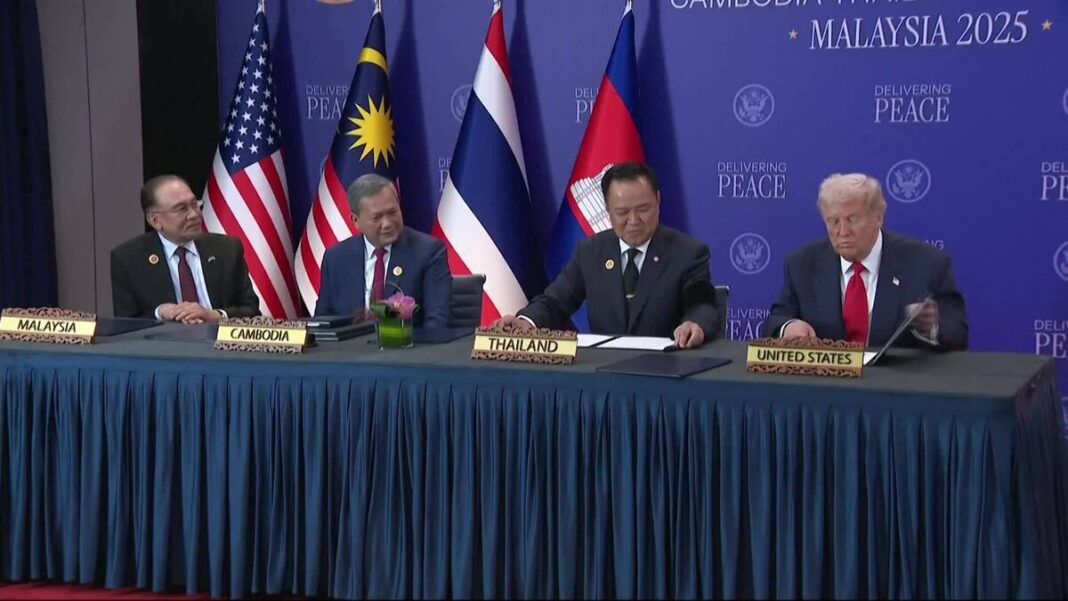The Diplomatic Dance: Trump, Thailand, and Cambodia’s Border Agreement
In recent months, the geopolitical landscape of Southeast Asia has witnessed significant developments, particularly concerning the long-standing border dispute between Thailand and Cambodia. At the center of this diplomatic effort is former President Donald Trump, who has taken an active role in brokering a ceasefire and facilitating a formal agreement between the two nations. The backdrop of this initiative includes Trump’s ambitions for international recognition, particularly the Nobel Peace Prize.
Historical Context of the Dispute
The border dispute between Thailand and Cambodia has deep historical roots, revolving largely around areas rich in cultural heritage and natural resources. The most notable flashpoint has been the Preah Vihear temple, a UNESCO World Heritage site that has been a source of contention since the early 2000s. National pride and claims to these territories fuel both nations’ concerns, escalating tensions that have at times resulted in violent confrontations.
Understanding the complexity of this dispute is crucial. Years of historical animosities and nationalistic sentiments have made the peace process arduous. Yet, the recent negotiations signify a turning point, inspired by external diplomatic intervention.
Trump’s Role in the Ceasefire
In what many might view as an unexpected twist in foreign diplomacy, Donald Trump has positioned himself as a mediator in this regional conflict. Utilizing his unique approach to international relations—often characterized by direct engagement and unorthodox strategies—Trump facilitated dialogue between the disputed nations. His influence during this negotiation was key in promoting the idea of bilateral cooperation over hostilities.
Leveraging his administration’s resources and relationships, he helped organize peace talks. These discussions have aimed at de-escalating tensions while fostering a mutual understanding, a step crucial for long-term stability in the region.
The Agreement and Its Implications
The agreement formalized by Trump represents a commitment to peace and cooperation. It includes protocols for managing border security, trade facilitation, and cultural exchanges, highlighting a comprehensive approach to diplomacy. Such measures not only aim to resolve the immediate issue but also seek to lay a foundation for future collaboration between Thailand and Cambodia.
The implications of this agreement stretch beyond the two countries involved. Stability in Southeast Asia is essential for regional economic growth, influencing trade routes and investment opportunities. Moreover, a successful resolution could serve as a benchmark for resolving similar disputes in the region, showcasing the efficacy of diplomatic engagement over military confrontation.
The Nobel Peace Prize Ambitions
As Trump navigates these diplomatic waters, his aspirations for a Nobel Peace Prize loom large. Historically, the Nobel Committee has awarded the peace prize to individuals and leaders who make significant contributions to resolving conflicts. By positioning himself as a peacemaker, Trump is not merely seeking accolades but attempting to reshape his legacy through tangible achievements in international relations.
This ambition adds a layer of complexity to the negotiations. While it may bolster the urgency for a resolution, critics argue that it risks prioritizing image over substance. Nevertheless, the mere act of engagement demonstrates a shift in the traditional paradigms of diplomatic interactions, spotlighting the role of powerful leaders in peace processes.
Regional Reactions and Future Considerations
The announcement of the agreement has elicited varied reactions within the region and beyond. Some view Trump’s involvement with skepticism, questioning the motivations behind his engagement. Others, however, acknowledge the potential for a stronger ASEAN framework should this agreement succeed.
Both Thailand and Cambodia’s domestic politics also influence perceptions of the agreement. National leaders must sell this peace initiative to their respective populations, often caught between national pride and the benefits of cooperation. The challenge will be to ensure that the agreement does not become merely a symbolic gesture but leads to actionable changes.
Conclusion
The intersection of diplomacy and personal ambition has crafted a unique narrative in the ongoing border discussions between Thailand and Cambodia. With Trump as a pivotal figure in this dialogue, the potential for a more peaceful Southeast Asia may be on the horizon. It remains to be seen whether this agreement will create lasting change, but the importance of such diplomatic endeavors cannot be overstated. The path forward will require careful navigation of both domestic and international expectations, shaping the future of a region marked by rich histories and complex relationships.



